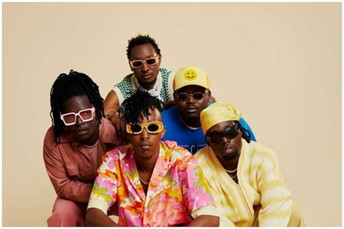Recently, Matata re-released their single Mpishi featuring Bien, a track that had initially been flagged down due to copyright claims. Since its re-upload, Mpishi has soared past 1.3 million views on YouTube in just eight days—an impressive feat that underscores both the group’s magnetic appeal and the public’s anticipation of their audiovisual artistry. With this renewed momentum, Matata is once again affirming their place as one of Kenya’s most visually and sonically adventurous acts.
The group comprises four versatile artists—Freddy Milanya (Freddy), Marcos Ojiambo (Marcus), Richie Mathu (Richie), and Festus Mwenda (Festus)—each bringing a distinct flair to their collective sound. Before forming Matata, the members worked as backup dancers for the acclaimed Afro-pop band Sauti Sol, an experience that sharpened their stage presence and deepened their understanding of performance artistry. Their music marries Gengetone’s raw street energy with polished Afropop melodies, layered vocals, and playful lyricism, creating a soundscape that is both familiar and refreshingly offbeat. This stylistic fusion, along with their bold visual choices, positions Matata as a quintessentially alternative group in the Kenyan music scene—one whose approach can be compellingly understood through the lens of hipster culture, where authenticity, irony, and a rejection of the mainstream become markers of creative identity.
What Is Hipster Culture?
Hipster culture, as a social and aesthetic phenomenon, finds its roots in the mid-20th century, though the term itself has evolved significantly over time. Originally emerging in the 1940s, the word “hipster” was used to describe white jazz aficionados who adopted the mannerisms, slang, and fashion of Black jazz musicians. These early hipsters were drawn to the countercultural cool of the Harlem Renaissance and the bebop scene, rejecting mainstream norms in favor of what they perceived as a more “authentic” and intellectually liberated lifestyle.
By the early 2000s, the hipster had undergone a major cultural reinvention. No longer associated with jazz, the term came to signify a loosely defined subculture of mostly urban, educated, and often middle-class young people who gravitated towards alternative music, vintage fashion, artisanal goods, and an ironic detachment from mainstream pop culture. Williamsburg in Brooklyn, Silver Lake in Los Angeles, and Shoreditch in London became epicenters of this modern hipster revival, as cafes, record stores, and bicycle shops populated gentrifying neighborhoods and projected an image of curated authenticity.
The key markers of hipster culture include thrift-store chic fashion (such as flannel shirts, skinny jeans, beanies, and retro sneakers), a preference for obscure or non-mainstream music, an interest in independent film and literature, and a taste for local, organic, or craft-based products—whether coffee, beer, or leather goods. Cultural irony and a commitment to “being different” often define the hipster sensibility, but paradoxically, this pursuit of uniqueness led to a globalized aesthetic that could be bought, sold, and mimicked.Major global stars and brands have co-opted the hipster aesthetic, making it a marketable commodity rather than a subversive cultural stance. Celebrities like Kanye West, Pharrell Williams, and Solange Knowles have drawn heavily from hipster fashion and art styles, infusing their work with the hallmarks of the subculture while leveraging their mass appeal. Likewise, global fashion houses and tech companies have capitalized on the aesthetic—from Apple’s minimalist branding to the rise of normcore and “ugly” fashion on the runway. Thus, while hipster culture began as a rebellion against the mainstream, it has, in many ways, become embedded within the very system it sought to critique.
Can Matata Be Considered Kenyan Hipsters?
Matata’s rise to prominence has been as much about visual identity as it has been about musical innovation, making them a compelling case study in the emergence of a Kenyan hipster aesthetic. While hipsterism in the Western sense is often tied to indie rock, lo-fi production, and ironic detachment, Matata reinterprets these impulses through the lens of Nairobi’s urban youth culture and the diasporic experience of African identity in a globalized world. Their sound—rooted in Gengetone but layered with elements of funk, Afropop, trap, and neo-soul—resists easy categorization. This genre fluidity itself is a hallmark of hipster subcultures, which thrive on hybridity, experimentation, and resistance to mainstream formulas.
Lyrically and sonically, Matata plays with nostalgia and novelty. Songs like Mapema and Gengetone Love simultaneously riff on street culture and romantic ideals, all while being underscored by quirky beats, auto-tuned harmonies, and unpredictable shifts in rhythm. Their collaboration with Bien on Mpishi further blurs the lines between high and low culture, with culinary metaphors, danceable grooves, and a cheeky sensuality that feels both playful and avant-garde.
Visually, Matata’s music videos serve as the most explicit manifestation of their hipster sensibility, not only through costume and set design but also in how they are shot, edited, and choreographed. Their use of saturated color palettes, nostalgic textures, and retro formats is deliberate, evoking an analog sensibility that stands in stark contrast to the ultra-slick, hyper-commercial visuals common in mainstream African pop. For example, many of their videos adopt a film grain filter, VHS-style distortion, or jump cuts reminiscent of lo-fi cinema, echoing techniques popularized by indie filmmakers and the visual art movements of Tumblr-era hipster culture.
Editing plays a crucial role. Rather than the high-definition gloss and linear narratives seen in conventional pop music videos, Matata’s visuals often embrace experimental techniques—freeze frames, quick zooms, stuttering slow motion, abrupt cuts, and rhythmic syncing to beat changes. This approach mirrors the ethos of spontaneity and controlled chaos found in their sound. In Chini Chini, for instance, scenes abruptly shift between domestic kitchen spaces and absurdist outdoor setups, all stitched together with rapid transitions and fisheye lens distortions that lend the entire video a surreal, almost postmodern feel. The visual dissonance is not only accepted—it’s curated.
Their use of costume design and set props also aligns with a hipster logic of intentional eclecticism. Outfits clash in tone but not in attitude—bucket hats meet knitted vests, animal prints are paired with sportswear, and vintage sunglasses complete ensembles that might have come from a Nairobi thrift store or a Berlin flea market. In Mapema, the group dons outfits that feel both flamboyant and understated, creating a playful tension that’s echoed by the kitschy background props—such as floral sofas in outdoor settings, mismatched furniture, and neon lighting that seems to parody excess.
Moreover, Matata frequently incorporates dance choreography that feels ironic and referential. Their routines mix popular TikTok moves with traditional African dance styles, performed with a knowing wink that suggests they are in on the joke. There is a performative self-awareness in how they frame their bodies and expressions, playing characters who are simultaneously cool and clownish—a gesture that undermines the hyper-serious masculinity often demanded of male artists in Gengetone and Afrobeats. This ironic detachment, coupled with high-concept visuals and lo-fi editing techniques, solidifies their position as not just musicians, but postmodern performers with a keen sense of aesthetic play.
In this sense, Matata can be considered Kenyan hipsters—not because they mimic Brooklyn or Berlin aesthetics, but because they embody the ethos of reinvention, irony, and cultural collage that defines hipsterism. They offer an alternative to the overly packaged celebrity culture of Afrobeat megastars, while simultaneously engaging with it on their own terms. Their work is not just entertainment; it’s a commentary on what it means to be stylish, expressive, and different in a world saturated with sameness.
Numbers Don’t Lie
Beyond their stylish visuals and genre-defying sound, Matata’s impact is measurable in cold, hard figures. In the notoriously competitive digital music landscape, the group has racked up millions of views across YouTube, cementing their place as one of Kenya’s most exciting music exports. At the time of writing, their re-uploaded single Mpishi featuring Bien has already amassed over 1.3 million views in just under a week, following a brief takedown due to copyright issues. This comeback alone is testament to the group’s cultural momentum and the loyalty of their fanbase.
- Smash Hits featuring other Acts
| Song Title |
Views |
Period of video existence |
| Inakubalika featuring Watendawili |
11 M |
1 yr |
| Mare Mare featuring Lamaz Span KOB |
7.2M |
5 yrs |
| Oversized Tshirt featuring Sauti Sol |
5.5 m |
2 yrs |
| Chini Chini Featuring Mejja |
5.2 M |
3 yrs |
| Mpishi featuring Bien |
1.3 M |
8 days since re-release |
| Achuu featuring Stella Mwangi |
1.2 M |
4 yrs |
But Mpishi is far from an outlier. From their early days, Matata has shown an uncanny ability to draw eyeballs and ears. One of their earliest breakout videos, Mare Mare, which was their second release and first collaborative single, proved that they could go beyond the novelty of Gengetone and build something with staying power. The track’s danceable beat, playful lyrics, and visually humorous storytelling set the tone for much of their future work. With its infectious hook and DIY charm, it quickly went viral and remains a fan favorite.
Another notable visual and sonic moment came with Achuu, featuring veteran Norwegian-Kenyan rapper Stella Mwangi. The track seamlessly bridged generations and geographies, blending Stella’s seasoned cadence with Matata’s energetic irreverence. The video—marked by crisp choreography and cinematic camera work—highlighted the group’s continued refinement of their aesthetic, signaling that they could go head-to-head with big industry names and still maintain their unique vibe.
Perhaps the most high-profile collaboration to date has been Oversized T-Shirt, created with Sauti Sol during a pivotal moment—the beloved boy band’s announcement of their hiatus to focus on solo careers. The song was not only a symbolic handing of the torch, but also a perfect blend of Sol’s soulful harmonies and Matata’s funky, cheeky energy. The visuals echoed this generational synthesis, mixing classic R&B tropes with Matata’s colorful, offbeat flair. It was an instant fan favorite and a staple on playlists across Africa and the diaspora.
| Song Title |
Views |
Period of video existence |
| This love |
2 M |
2 yrs |
| Gengetone love |
1.9 M |
4 yrs |
| Siko Fiti |
1.4 M |
2yrs |
| Ngata |
1.3 M |
1 yr |
| Mapema |
1.2 M |
4 yrs |
Interestingly, not all of Matata’s hits have crossed the million-view mark, despite being beloved by DJs, playlist curators, and radio producers. Songs like Ruracio, Wababa, as well as Pombe na Kizungu Mingi and Matatu that were part of a collaborative EP done with superstars Bensoul and Nviiri the Storyteller have become near-ubiquitous in clubs and on Kenyan radio. Their rhythmic versatility, local slang, and unapologetically Kenyan flair have made them perfect for dancefloors and drive-time radio alike. Some of these tracks have even won awards or earned nominations at platforms like the AFRIMA (All Africa Music Awards) and Pulse Music Video Awards, even without reaching the streaming numbers of viral hits. This speaks to Matata’s dual appeal: both mainstream and alternative, radio-friendly and niche.
- Impactful songs with less than 1M views
| Song Title |
Views |
Period of video existence |
| Pombe na Kizungu Mingi featuring Bensoul and Nviiri the Storyteller |
881 K |
3 yrs |
| Ruracio |
765 K |
4 yrs |
| Wababa |
654 K |
3 yrs |
| Matatu featuring Bensoul and Nviiri the Storyteller |
486 K |
|
Over the years, the group has garnered a slew of accolades that validate their cultural footprint. They have been nominated for and won awards both in Kenya and abroad, including recognition at the Cafe Ngoma Awards and diaspora-based honors in Norway and the UK. Their performances at international festivals—from Oslo to Kigali—have been praised for their energy, choreography, and showmanship. In 2022, they were listed among the “Top 10 African Artists to Watch” by several music blogs and were spotlighted by BBC Africa as part of the new wave of Kenyan creatives redefining pop culture. Indeed, the numbers don’t lie—but they only tell part of the story. Matata’s real power lies in how they’ve managed to cultivate a movement that’s as local as it is global, as hip as it is grounded. Their ability to bridge underground aesthetic values with chart-worthy appeal is rare—and in that sense, perhaps they’re not just hipsters; they’re pioneers.
Written by Otieno Arudo




